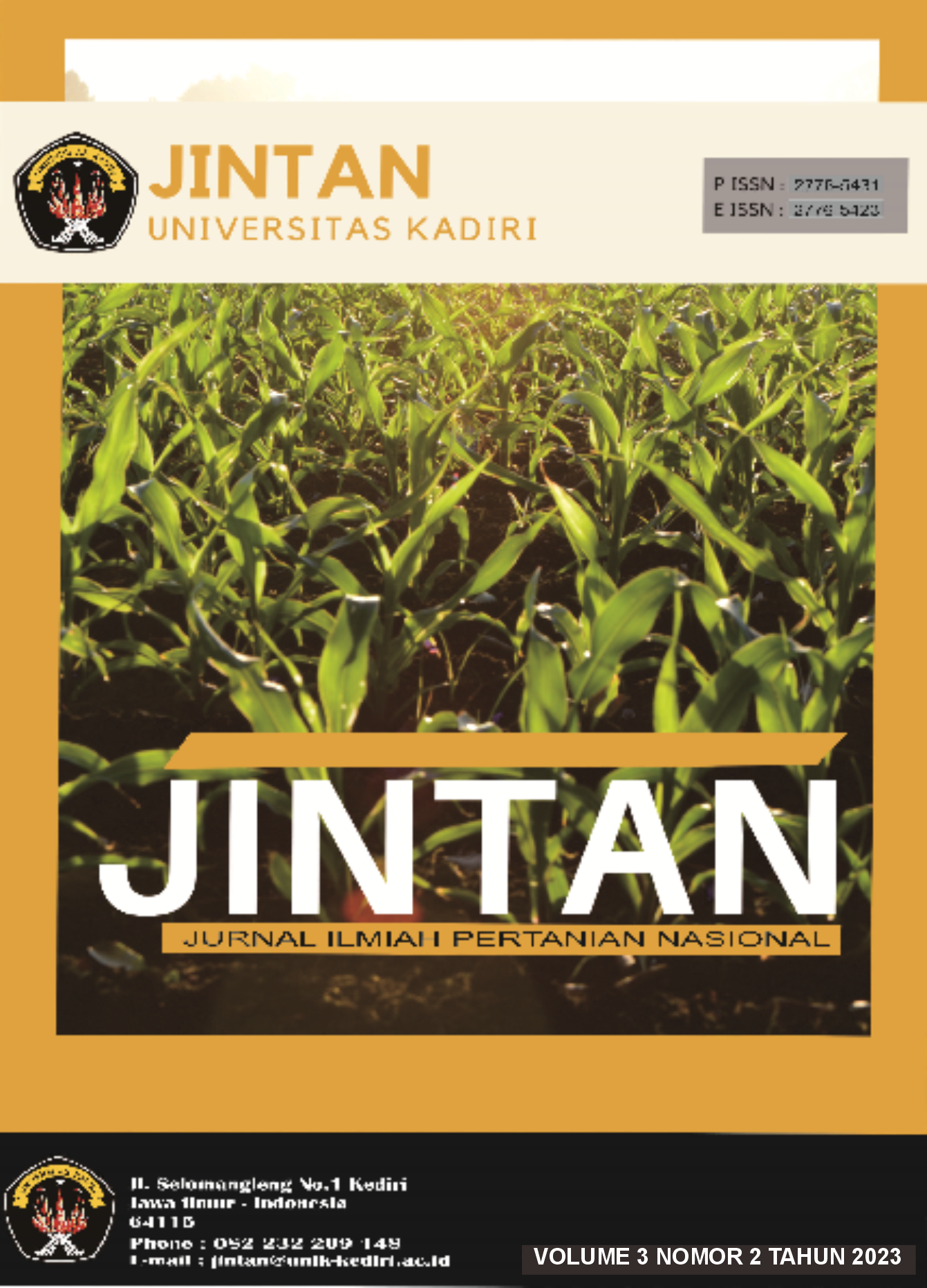Efektivitas Interaksi dan Pengaruhnya Aplikasi Pupuk Organik Cair (POC) Terhadap Pertumbuhan dan Hasil dari Dua Varietas Kangkung Darat (Ipomoea peptans Poir.)
DOI:
https://doi.org/10.30737/jintan.v3i2.4720Keywords:
Fertilizer, Kangkung, Response, Results, VarietyAbstract
Kangkung is classified as a vegetable plant that is in great demand by Indonesian people. Fertilization is needed to increase the production of kangkung. Fertilizing plants can be done using organic materials because they are environmentally friendly. Organic material that can be used as fertilizer is cow urine. This study aims to determine the effectiveness of the interaction and its effect on the growth and yield of two varieties of kangkung (Ipomoea peptans Poir.) due to the application of liquid organic fertilizer (POC). The research was carried out on dry land. The method used in this study was a randomized block design (RBD), with 2 factorials, namely the application of fertilizer from cow urine P1 (without applying fertilizer), P2 (giving POC cow urine 40 ml/1 l water), P3 (application of POC urine cow as much as 60 ml/1 l water), P4 (application of POC cow urine as much as 80 ml/1 l water). At the same time, the second factor was variety, namely V1 (Bisi) and V2 (Serimpi). The treatments were combined into 8 treatments with 4 repetitions so that 32 experimental plots were obtained. The observed variable was the increase in height, plant weight and number of leaves. The data analysis was the mean test between treatments, then carried out with a BNT 5% test. The results of the analysis of variance showed that there was no interaction between giving POC cow urine to ground kangkung varieties. However, giving 60 ml/1 liters of POC of cow urine (P3) gave the best results for each growth parameter studied. Further research still needs to be done to make the results more optimal.
Kangkung merupakan tanaman sayur yang banyak diminati masyarakat Indonesia. Untuk meningkatkan produksi kangkung, diperlukan pemupukan. Dalam memupuk tanaman bisa dilakukan dengan menggunakan bahan organik karena sifatnya yang ramah lingkungan. Bahan organik yang bisa digunakan sebagai pupuk adalah urine sapi. Penelitian ini memiliki tujuan untuk mengetahui Efektivitas interaksi dan pengaruhnya pertumbuhan dan hasil dari dua varietas kangkung darat (Ipomoea peptans Poir.) akibat pengaplikasian pupuk organik cair (POC). Penelitian dilakukan di lahan tegal. Metode yang telah dilakukan dalam penelitian ini adalah Rancangan Acak Kelompok (RAK), dengan 2 faktorial, yaitu pengaplikasian pupuk dari urin sapi P1 (tanpa pemberian pupuk), P2 (pemberian POC urine sapi 40ml/1 l air), P3 (pengaplikasian POC urine sapi sebanyak 60ml/ 1 l air), P4 (pengaplikasian POC urine sapi sebanyak 80ml/ 1 l air). Sedangkan faktor kedua adalah Varietas, yaitu V1 (Bisi) dan V2 (Serimpi). Perlakuan dikombinasikan menjadi 8 perlakuan dengan ulangan sebanyak 4 kali sehingga didapatkan 32 petak percobaan. Variabel pengamatan adalah mengamati pertambahan tinggi, bobot tanaman dan jumlah daun. Analisi data yang digunakan yaitu dengan uji rerata antar perlakuan, yang kemudian dilakukan uji BNT 5%. Hasil analisis ragam menunjukkan bahwa tidak terjadi interaksi antara pemberian POC Urine Sapi terhadap varietas kangkung darat. Akan tetapi, pemberian POC Urine Sapi sebesar 60ml/1 l air (P3) memberikan hasil terbaik setiap parameter pertumbuhan yang diteliti. Masih perlu dilakukan penelitian lanjutan supaya hasil lebih optimal.
References
Asra, R., Samarlina, R. A., & Silalahi, M. (2020). Hormon Tumbuha. Journal of Chemical Information and Modeling, 53(9).
Handini, R., K. (2019). Research Trends in Envirotmental Sciens. Implementation Science, 2(1), 1–24.
Idris, M. (2019). Survei BPS: Orang RI Kurang Makan Sayur, Kangkung Paling Digemari. https://money.kompas.com
Jigme, Jayamangkala, N., Sutigoolabud, P., Inthasan, J., & Sakhonwasee, S. (2015). The Effect of Organic Fertilizers on Growth and Yield of Broccoli (Brassica oleracea L. var. Italica Plenck cv. Top Green). Journal of Organic Systems, 10(1), 9–14.
Mansyur, N. I., Pudjiwati, E., & Murtilaksono, A. (2021). ). Pupuk dan Pemupukan. Syiah Kuala University Press.
Pratiwi, Y. I., Huda, N., & Gunawan, B. (2017). Improvement Of Rating Of Stream Bud Chips Plant With Waste Liquid Of Cattle Farm. Jurnal Hasil Penelitian, 2(1).
Subdirektorat Statistik Hortikultura. (2018). Statistik Tanaman Sayuran dan Buah-buahan Semusim Indonesia2017.Badan Pusat Statistik.
Zamrodah, Y. (2016). Efektivitas Berbagai Konsentrasi Pupuk Cair Urine Sapi pada Pertumbuhan dan Hasil Tanaman Kubis Bunga (Brassica Oleracea var. Botrytis L.). Effectiveness, 15(2).
Downloads
Published
Issue
Section
License
Authors who publish in this journal agree to the following terms:
- Authors retain copyright and grant the journal right of first publication with the work simultaneously licensed under a Creative Commons Attribution License (https://creativecommons.org/licenses/by-nc-nd/4.0/) that allows others to share the work with an acknowledgment of the work's authorship and initial publication in this journal. Permitted third party reuse is defined by the Creative Commons Attribution-NonCommercial-NoDerivs (CC BY-NC-ND). This permission allows users to copy and distribute the Article, provided this is not done for commercial purposes and further does not permit distribution of the Article if it is changed or edited in any way, and provided the user gives appropriate credit (with a link to the formal publication through the relevant DOI), provides a link to the license, and that the licensor is not represented as endorsing the use made of the work.
- Authors are able to enter into separate, additional contractual arrangements for the non-exclusive distribution of the journal's published version of the work (e.g., post it to an institutional repository or publish it in a book), with an acknowledgment of its initial publication in this journal.
- Authors are permitted and encouraged to post their work online (e.g., in institutional repositories or on their website) prior to and during the submission process, as it can lead to productive exchanges, as well as earlier and greater citation of published work.
- For open-access publishing, authors have the right to share their articles in the same ways permitted to third parties under the relevant user license, as well as certain scholarly usage rights.
Deprecated: json_decode(): Passing null to parameter #1 ($json) of type string is deprecated in /home/ojs.unik-kediri.ac.id/public_html/plugins/generic/citations/CitationsPlugin.php on line 68




